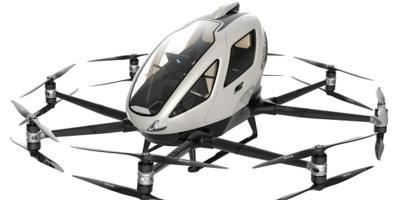Unleashed in the East—More or Less
EHang Holdings Limited, a Guangzhou-based Chinese developer of Autonomous Aerial Vehicles (AAV), maintains progress is being made on the certification of the company’s EH216-S, a proprietary passenger-carrying Unmanned Aerial Vehicle (UAV) platform.

EHang is working in cooperation with the Southern Regional Administration of the Civil Aviation Administration of China (CAAC) to secure a Production Certificate (PC) for the machine. Notably, the majority of the requisite documentation reviews, definitions, and practical assessments germane to the issuance of the vehicle’s PC have been completed. Following CAAC’s issuance of the sought-after PC, EHang will commence production of its inaugural run of EH216-S passenger-carrying UAVs, customer deliveries of which are slated to begin in 2023’s fourth-quarter.
On 13 October 2023, the CAAC granted type certification to the EH216-S, thereby authorizing the EH216-S’s utilization in commercial passenger-carrying operations—a world first. The type certificate was issued during a ceremony in Beijing.
Operating under the so-called progressive risk principle, EHang will gradually lift self-imposed initial operational limitations on its EH216-S UAV with the goal of safely actualizing comprehensive unmanned commercial operations across urban areas. EHang prioritizes safe operations and accountability to the public.
To ensure safety, EHang will closely monitor new routes during the first phase of commercial operations. Moreover, the company will position extra observers in areas beyond the operators’ visual line of sight, thereby satisfying requirements for Beyond Visual Line-Of-Sight (“BVLOS”) operations.
EHang’s EH216-S will not operate over open water. However, according to route- requirements, the vehicle will operate over smaller bodies of water—e.g., lakes, rivers, and the seaside.

EHang founder, chairman, and CEO Huazhi Hu set forth: “Safety is the lifeline of the aviation industry. Ensuring a rigorous and systematic approach to the research and development, production, operation, and management of aerial vehicles remains a core value for the CAAC, EHang, and all our collaborators. We will continue to innovate and maintain our leading advantages. In accordance with the CAAC’s safety standards and airworthiness requirements, we are committed to ensuring the safety of every passenger and cementing a solid foundation for commercial operations.”
Mr. Hu added: “Looking ahead, we will further advance UAV passenger-carrying flight operations and full-scale commercial deployments to achieve milestones in the development of the global low-altitude economy.”
The EHang EH216-S is a two-seat, unmanned, eVTOL multi-copter compelled aloft by an electric propulsion scheme turning 16 rotors in a coaxial double-blade design. The contraption is capable, ostensibly of maintaining flight for an interval of 25-minutes, during which it can allegedly cover distances of up to 22-nautical-miles. While the preponderance of EH216-S test-flight, to date, have been manned, the aircraft is intended to operate autonomously, monitored by ground personnel stationed at an EHang command-and-control facility. Austrian aerostructures supplier FACC AG partnered with EHang to certify and produce the aircraft in Europe, within simpler certification requirements for takeoff weights below 1,320-pounds.
On 29 September 2023, EHang delivered five units of its EH216-S Shenzhen Boling Holding Group Co., Ltd. (Boling), which intends to acquire a total of one-hundred specimens of the aircraft with which the company—in partnership with Shenzhen’s Bao’an District government—intends to found an aerial tourism and sightseeing enterprise.
The five-score EH2016-S AAVs will support regular flight operations at EHang’s inaugural Urban Air Mobility (UAM) Operation Demonstration Center in the Bao’an District’s OH Bay enclave. Boling and local authorities contend lessons learned at OH Bay will inform the near-future founding of commercial EH216-S operations in Shenzhen, and contribute significantly to the development of China’s so-called low-altitude economy—of which UAM is a key component.
According to the Chinese Communist government’s Plan for Innovative Development of Low-Altitude Economy Industries in Bao'an District, Shenzhen (2023-2025), UAM—in addition to sightseeing and tourism—will sustain sectors the likes of aerial logistics, emergency rescue, city management, urban planning, industrial monitoring and security, and entertainment.

Currently, over fifty low-altitude unmanned flight routes across a network comprising upwards of one-hundred landing-platforms are planned throughout the Shenzhen region.
Since the CAAC’s formal, 2021 acceptance of EHang’s application for EH216-S type certification, EHang’s engineers have worked closely with the CAAC toward validating the aircraft’s constituent technologies. All told, the certification process spanned in excess of one-thousand days (2.74-years) and more than forty-thousand test-flights.
During the validation process, the EH216-S underwent extensive laboratory, ground, and flight testing at numerous sites across China. Subject tests included but were not limited to main material performance, structural strength, flame resistance, crashworthiness, gas toxicity, environmental conditions of equipment and systems, software simulation, data links, ground control stations, overall system functionality, electromagnetic compatibility, flight performance and flight stability characteristics. The validation process scrutinized components, equipment, and the aggregate aircraft for manufacturing defects, faults, and interferences.
 Bolen Gives Congress a Rare Thumbs-Up
Bolen Gives Congress a Rare Thumbs-Up The SportPlane Resource Guide RETURNS!!!!
The SportPlane Resource Guide RETURNS!!!! Buying Sprees Continue: Textron eAviation Takes On Amazilia Aerospace
Buying Sprees Continue: Textron eAviation Takes On Amazilia Aerospace Hawker 4000 Bizjets Gain Nav System, Data Link STC
Hawker 4000 Bizjets Gain Nav System, Data Link STC Echodyne Gets BVLOS Waiver for AiRanger Aircraft
Echodyne Gets BVLOS Waiver for AiRanger Aircraft





